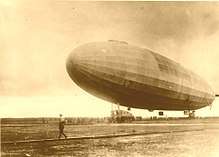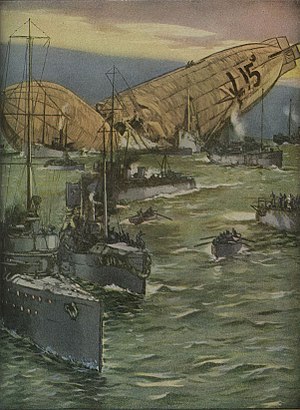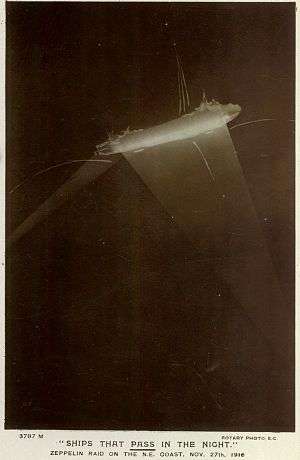Zeppelin LZ 72
LZ 72 (navy designation L 31) was an R Class super-zeppelin belonging to the Imperial German Navy. It was commanded by Kapitänleutnant Heinrich Mathy, an experienced commander, and took part in several raids over London during World War I.[1] It also participated in a reconnaissance role during the Sunderland raid of 19 August 1916. Its last flight was launched late at night on 1 October 1916. Several miles north of London, it was caught in searchlights and anti-aircraft fire. During this engagement, 2nd Lt. Wulfstan J. Tempest was on patrol and spotted the zeppelin. He proceeded to engage the airship with incendiary rounds, causing the ship to burst into flames and crash in a field near Potter's Bar.[2][3] After this disastrous crash, the Imperial German Navy began decreasing its amount of zeppelin raids. The entire crew died, and were originally buried there but were transported to Cannock Chase in the 1960s.[1]
| LZ 72 | |
|---|---|
 | |
| L 31 (LZ 72) in flight | |
| Type | Zeppelin R Class |
| Construction number | LZ 72 |
| Serial | L31 |
| First flight | 12 July 1916 |
| Owners and operators | Imperial German Navy |
| Last flight | 2 October 1916 |
| Fate | Destroyed |
Operators

Oakmere Park
In September 2019 it was announced that Hertsmere Borough Council agreed planning permission for a Super Zeppelin Tower in the junior play area within Oakmere Park.[4]
Specifications (LZ 72 / Type R zeppelin)
Data from Zeppelin : rigid airships, 1893-1940[5]
General characteristics
- Crew: 17-19
- Capacity: 32,400 kg (71,430 lb) typical disposable load
- Length: 198 m (649 ft 7 in)
- Diameter: 23.9 m (78 ft 5 in) maximum
- Fineness ratio: 8.24
- Volume: 55,200 m3 (1,950,000 cu ft) in 19 gas cells
- Empty weight: 31,400 kg (69,225 lb)
- Gross weight: 32,908 kg (72,550 lb)
- Fuel capacity: 6,250 kg (13,779 lb)
- Useful lift: 63,800 kg (140,700 lb)
- Powerplant: 5 × Maybach HS Lu 6-cylinder water-cooled in-line piston engines, 180 kW (240 hp) each
- Propellers: 4-bladed Lorenzen fixed-pitch propellers
Performance
- Maximum speed: 103 km/h (64 mph, 56 kn)
- Cruise speed: 81 km/h (50 mph, 44 kn)
- Range: 7,400 km (4,600 mi, 4,000 nmi) at 81 km/h (50 mph; 44 kn)
- Service ceiling: 3,900 m (12,800 ft) static
- Rate of climb: 10 m/s (2,000 ft/min) maximum permitted (r-class)
Armament
- Guns: machine-guns in hull-top positions and gondolas
- Bombs: up to 60 bombs to a total of 5,000 kg (11,023 lb)
Zeppelins shot down over the UK
Airships made about 51 bombing raids on Britain during the war. These killed 557 and injured another 1,358 people. More than 5,000 bombs were dropped on towns across Britain, causing £1.5 million in damage. 84 airships took part, of which 30 were either shot down or lost in accidents.[6]
| Zeppelins shot down over the UK | ||||||||||||||||||||||||||||||||||||||||||||||||||||||||||||||||||||||||
|---|---|---|---|---|---|---|---|---|---|---|---|---|---|---|---|---|---|---|---|---|---|---|---|---|---|---|---|---|---|---|---|---|---|---|---|---|---|---|---|---|---|---|---|---|---|---|---|---|---|---|---|---|---|---|---|---|---|---|---|---|---|---|---|---|---|---|---|---|---|---|---|---|
|
References
- "Mathy, Kapitanleutnant Heinrich (1883-1916". www.gwpda.org. Retrieved 26 April 2018.
- Morgan, Tom (April 2004). "Decisions at Potters Bar". Tom Morgan's HELLFIRE CORNER GREAT WAR WEB-PAGES. Retrieved 5 March 2019.
- "Death of A Zeppelin – The L-31 is shot down - History Channel on Foxtel". historychannel.com.au. 30 September 2016. Retrieved 26 April 2018.
- "A Zeppelin is coming to Oakmere Park - again! - Hertsmere Borough Council". www.hertsmere.gov.uk. Retrieved 2019-10-01.
- Brooks, Peter W. (1992). Zeppelin : rigid airships, 1893-1940. Washington, D.C.: Smithsonian Institution Press. pp. 95-99. ISBN 1560982284.
- Liddell Hart, Sir Basil Henry (1934). A History of the World War 1914-1918. Faber. p. 76. ISBN 9780304936533. - Total pages: 635


